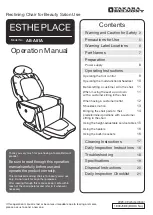
Glossary
G-7
G
Code 11
A very high density, discrete, numeric bar code developed by Intermec. The character set
includes the numbers 0 through 9 and the dash character (-). Each character is
represented by a standalone group of three bars with two included spaces. This code is
not self-checking. One or two check digits provide data security. Code 11 is most
extensively used in labeling telecommunications components and equipment. Its
maximum density is 15 characters per inch.
Code 16K
A two-dimensional (stacked rows), ultra-high density bar code symbology. It is based on
Code 128 and is used widely to label unit-dose packaging for the healthcare industry.
Code 2 of 5 (2 of 5)
A discrete, self-checking code for encoding numeric data only. The bars encode
information and the spaces separate individual bars. It can achieve densities of 15
characters per inch.
Code 39
A discrete, variable length, and self-checking bar code symbology. The character set is
uppercase A to Z, 0 to 9, dollar sign ($), period (.), slash (/), percent (%), space ( ), plus
(+), and minus (-). Code 39 can be extended to the full 128 ASCII character set by use of
a two-character encoding scheme (see full ASCII). Its maximum density is 9.8 characters
per inch.
Code 49
A multirow symbology for high data density. The last character in each row is used for
row checking and the last two characters of the symbol are used for overall checking. The
character set includes all 128 ASCII characters. Its maximum density is 93.3
alphanumeric characters per inch or 154.3 numeric characters per inch.
Code 93
A variable length, continuous bar code symbology using four element widths. It can be
used interchangeably with Code 39 when higher density printing is required. The
character set is the same as Code 39. Its maximum density is 14.8 characters per inch.
Code 128
A very high density alphanumeric symbology that supports the extended ASCII character
set. It is a variable length, continuous code that uses multiple element widths. Code 128’s
high density makes it useful when printing data in a limited space. Its maximum density
is 12.1 alphanumeric characters per inch or 24.2 numeric characters per inch.
Summary of Contents for Trakker Antares 2420
Page 1: ...TRAKKERAntares 2420and2425 Hand HeldTerminal P N 064024 006 User s Manual...
Page 15: ...nuggetf code39 Contents xv Glossary Index G I...
Page 16: ...xvi...
Page 24: ...xxiv...
Page 25: ...nuggetf code39 Getting Started 1...
Page 26: ...1 2...
Page 60: ...1 36...
Page 61: ...Learning How to Use the Terminal 2...
Page 62: ...2 2...
Page 103: ...Co de 39 Nugget Configuring the Terminal 3...
Page 104: ...Co de 39 Nugget 3 2...
Page 134: ...3 32...
Page 135: ...Operating the Terminal in a Network 4...
Page 136: ...4 2...
Page 173: ...Using Custom Applications 5...
Page 174: ...5 2...
Page 193: ...Troubleshooting 6...
Page 194: ...6 2...
Page 219: ...Running Diagnostics 7...
Page 220: ...7 2...
Page 243: ...Reader Command Reference 8...
Page 244: ...8 2...
Page 268: ...8 26...
Page 269: ...Configuration Command Reference 9...
Page 270: ...9 2...
Page 389: ...Terminal Specifications A...
Page 390: ...A 2...
Page 404: ...A 16...
Page 405: ...Full ASCII Charts B...
Page 406: ...B 2...
Page 415: ...International Character Support C...
Page 416: ...C 2...
Page 427: ...Using the Default Applications D...
Page 428: ...D 2...
Page 438: ...D 12...
Page 439: ...Glossary G...
Page 440: ...G 2...
Page 463: ...Index I...
Page 464: ...I 2...
Page 480: ...I 18...
















































